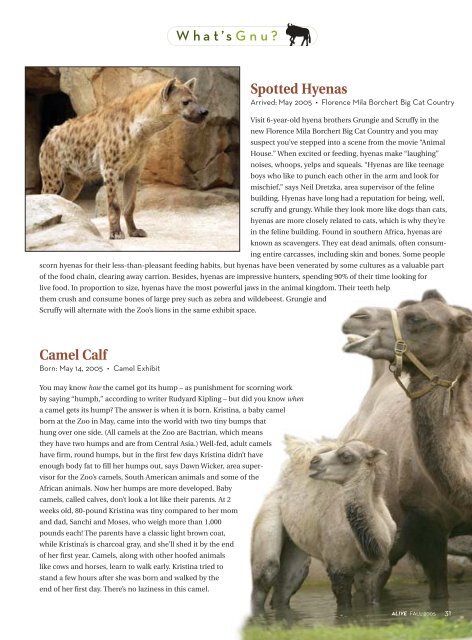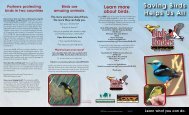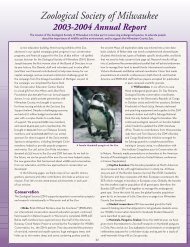AliveFall 2005 - Zoological Society of Milwaukee
AliveFall 2005 - Zoological Society of Milwaukee
AliveFall 2005 - Zoological Society of Milwaukee
Create successful ePaper yourself
Turn your PDF publications into a flip-book with our unique Google optimized e-Paper software.
Spotted Hyenas<br />
Arrived: May <strong>2005</strong> • Florence Mila Borchert Big Cat Country<br />
Visit 6-year-old hyena brothers Grungie and Scruffy in the<br />
new Florence Mila Borchert Big Cat Country and you may<br />
suspect you’ve stepped into a scene from the movie “Animal<br />
House.” When excited or feeding, hyenas make “laughing”<br />
noises, whoops, yelps and squeals. “Hyenas are like teenage<br />
boys who like to punch each other in the arm and look for<br />
mischief,” says Neil Dretzka, area supervisor <strong>of</strong> the feline<br />
building. Hyenas have long had a reputation for being, well,<br />
scruffy and grungy. While they look more like dogs than cats,<br />
hyenas are more closely related to cats, which is why they’re<br />
in the feline building. Found in southern Africa, hyenas are<br />
known as scavengers. They eat dead animals, <strong>of</strong>ten consuming<br />
entire carcasses, including skin and bones. Some people<br />
scorn hyenas for their less-than-pleasant feeding habits, but hyenas have been venerated by some cultures as a valuable part<br />
<strong>of</strong> the food chain, clearing away carrion. Besides, hyenas are impressive hunters, spending 90% <strong>of</strong> their time looking for<br />
live food. In proportion to size, hyenas have the most powerful jaws in the animal kingdom. Their teeth help<br />
them crush and consume bones <strong>of</strong> large prey such as zebra and wildebeest. Grungie and<br />
Scruffy will alternate with the Zoo’s lions in the same exhibit space.<br />
Camel Calf<br />
Born: May 14, <strong>2005</strong> • Camel Exhibit<br />
What’sGnu?<br />
You may know how the camel got its hump – as punishment for scorning work<br />
by saying “humph,” according to writer Rudyard Kipling – but did you know when<br />
a camel gets its hump? The answer is when it is born. Kristina, a baby camel<br />
born at the Zoo in May, came into the world with two tiny bumps that<br />
hung over one side. (All camels at the Zoo are Bactrian, which means<br />
they have two humps and are from Central Asia.) Well-fed, adult camels<br />
have firm, round humps, but in the first few days Kristina didn’t have<br />
enough body fat to fill her humps out, says Dawn Wicker, area supervisor<br />
for the Zoo’s camels, South American animals and some <strong>of</strong> the<br />
African animals. Now her humps are more developed. Baby<br />
camels, called calves, don’t look a lot like their parents. At 2<br />
weeks old, 80-pound Kristina was tiny compared to her mom<br />
and dad, Sanchi and Moses, who weigh more than 1,000<br />
pounds each! The parents have a classic light brown coat,<br />
while Kristina’s is charcoal gray, and she’ll shed it by the end<br />
<strong>of</strong> her first year. Camels, along with other ho<strong>of</strong>ed animals<br />
like cows and horses, learn to walk early. Kristina tried to<br />
stand a few hours after she was born and walked by the<br />
end <strong>of</strong> her first day. There’s no laziness in this camel.<br />
ALIVE FALL <strong>2005</strong> 31













